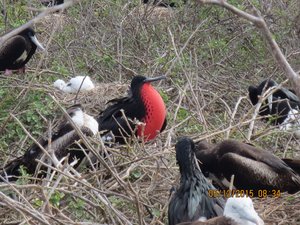Advertisement
Published: June 22nd 2017

 Male frigate
Male frigate
The males make a nest (sort of) and then display beside it to attract a female. If a male feels surpassed by a nearby competitor, he will try to puncture his rival's bag with his beak. If he's successful, the rival will have to wait till next year for his bag to repair itself. The main breeding time is Mar/Apr when the landscape is filled with nesting birds.Geo: -0.401009, -90.282
We cruised up here yesterday afternoon, past Baltra Island where the airport and bulk refuelling facility are located. Diesel for tourist boats is not subsidised and costs $2.80 per US gallon. On mainland Ecuador fuel is subsidised and diesel costs $1/gal.
The main viewing this morning was nesting frigate birds, blue-footed boobies and land iguanas. We had an earlier start because we needed to meet our allocated refuelling time window at 11am.
Feedback forms were handed out today, with a recommended tipping schedule of $25-30 per person per day for the crew, plus $8-10 pppd for the guide. At the top of the scale that would be US $480 per couple for the cruise. I don't think so. The ship is nicely appointed but the service was not up to my expectations. The opposite to our Kimberley cruise, really. Service on the Anakonda was also excellent.
Advertisement
Tot: 0.386s; Tpl: 0.013s; cc: 9; qc: 45; dbt: 0.0493s; 1; m:domysql w:travelblog (10.17.0.13); sld: 1;
; mem: 1.1mb

 Male frigate
Male frigate




